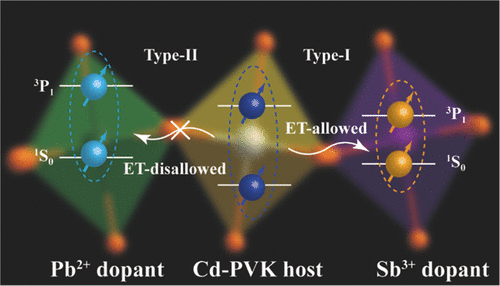Our official English website, www.x-mol.net, welcomes your feedback! (Note: you will need to create a separate account there.)
Ultrafast Study of Exciton Transfer in Sb(III)-Doped Two-Dimensional [NH3(CH2)4NH3]CdBr4 Perovskite
ACS Nano ( IF 17.1 ) Pub Date : 2021-09-15 , DOI: 10.1021/acsnano.1c06564 Jingjie Wu 1 , Xianli Li 1 , Xin Lian 1 , Binbin Su 2 , Junhong Pang 1 , Ming-De Li 1 , Zhiguo Xia 2 , Jin Z Zhang 3 , Binbin Luo 1, 4 , Xiao-Chun Huang 1, 4
ACS Nano ( IF 17.1 ) Pub Date : 2021-09-15 , DOI: 10.1021/acsnano.1c06564 Jingjie Wu 1 , Xianli Li 1 , Xin Lian 1 , Binbin Su 2 , Junhong Pang 1 , Ming-De Li 1 , Zhiguo Xia 2 , Jin Z Zhang 3 , Binbin Luo 1, 4 , Xiao-Chun Huang 1, 4
Affiliation

|
Antimony-based metal halide hybrids have attracted enormous attention due to the stereoactive 5s2 electron pair that drives intense triplet broadband emission. However, energy/charge transfer has been rarely achieved for Sb3+-doped materials. Herein, Sb3+ ions are homogeneously doped into 2D [NH3(CH2)4NH3]CdBr4 perovskite (Cd-PVK) using a wet-chemical method. Compared to the weak singlet exciton emission of Cd-PVK at 380 nm, 0.01% Sb3+-doped Cd-PVK exhibits intense triplet emission located at 640 nm with a near-unity quantum yield. Further increasing the doping concentration of Sb3+ completely quenches singlet exciton emission of Cd-PVK, concurrently with enhanced Sb3+ triplet emission. Delayed luminescence and femtosecond-transient absorption studies suggest that Sb3+ emission originates from exciton transfer (ET) from Cd-PVK host to Sb3+ dopant, while such ET cannot occur with Pb2+-doped Cd-PVK because of the mismatch of energy levels. In addition, density function theory calculations indicate that the introduced Sb3+ likely replace the Cd2+ ions along with the deprotonation of butanediammonium for charge balance, instead of generating Cd2+ vacancies. This work provides a deeper understanding of the ET of Sb3+-doped Cd-PVK and suggests an effective strategy to achieve efficient triplet Sb3+ emission beyond 0D Cl-based hybrids.
中文翻译:

Sb(III)掺杂二维[NH3(CH2)4NH3]CdBr4钙钛矿中激子转移的超快研究
由于具有立体活性的 5s 2电子对驱动强烈的三线态宽带发射,基于锑的金属卤化物杂化物引起了极大的关注。然而,Sb 3+掺杂材料很少实现能量/电荷转移。在此,使用湿化学方法将Sb 3+离子均匀掺杂到 2D [NH 3 (CH 2 ) 4 NH 3 ]CdBr 4钙钛矿 (Cd-PVK) 中。与 Cd-PVK 在 380 nm 处的弱单线态激子发射相比,0.01% Sb 3+掺杂的 Cd-PVK 在 640 nm 处表现出强烈的三线态发射,量子产率接近统一。进一步提高 Sb 3+的掺杂浓度完全淬灭 Cd-PVK 的单线态激子发射,同时增强 Sb 3+三线态发射。延迟发光和飞秒瞬态吸收研究表明 Sb 3+发射源于从 Cd-PVK 主体到 Sb 3+掺杂剂的激子转移 (ET) ,而这种 ET 不会发生在 Pb 2+掺杂的 Cd-PVK 中,因为不匹配的能量水平。此外,密度函数理论计算表明,引入的 Sb 3+可能取代 Cd 2+离子以及丁二铵去质子化以实现电荷平衡,而不是产生 Cd 2+空位。这项工作提供了对 Sb 3+ ET 的更深入理解掺杂的 Cd-PVK 并提出了一种有效的策略,以实现超越 0D Cl 基杂化体的高效三重态 Sb 3+发射。
更新日期:2021-09-28
中文翻译:

Sb(III)掺杂二维[NH3(CH2)4NH3]CdBr4钙钛矿中激子转移的超快研究
由于具有立体活性的 5s 2电子对驱动强烈的三线态宽带发射,基于锑的金属卤化物杂化物引起了极大的关注。然而,Sb 3+掺杂材料很少实现能量/电荷转移。在此,使用湿化学方法将Sb 3+离子均匀掺杂到 2D [NH 3 (CH 2 ) 4 NH 3 ]CdBr 4钙钛矿 (Cd-PVK) 中。与 Cd-PVK 在 380 nm 处的弱单线态激子发射相比,0.01% Sb 3+掺杂的 Cd-PVK 在 640 nm 处表现出强烈的三线态发射,量子产率接近统一。进一步提高 Sb 3+的掺杂浓度完全淬灭 Cd-PVK 的单线态激子发射,同时增强 Sb 3+三线态发射。延迟发光和飞秒瞬态吸收研究表明 Sb 3+发射源于从 Cd-PVK 主体到 Sb 3+掺杂剂的激子转移 (ET) ,而这种 ET 不会发生在 Pb 2+掺杂的 Cd-PVK 中,因为不匹配的能量水平。此外,密度函数理论计算表明,引入的 Sb 3+可能取代 Cd 2+离子以及丁二铵去质子化以实现电荷平衡,而不是产生 Cd 2+空位。这项工作提供了对 Sb 3+ ET 的更深入理解掺杂的 Cd-PVK 并提出了一种有效的策略,以实现超越 0D Cl 基杂化体的高效三重态 Sb 3+发射。



























 京公网安备 11010802027423号
京公网安备 11010802027423号